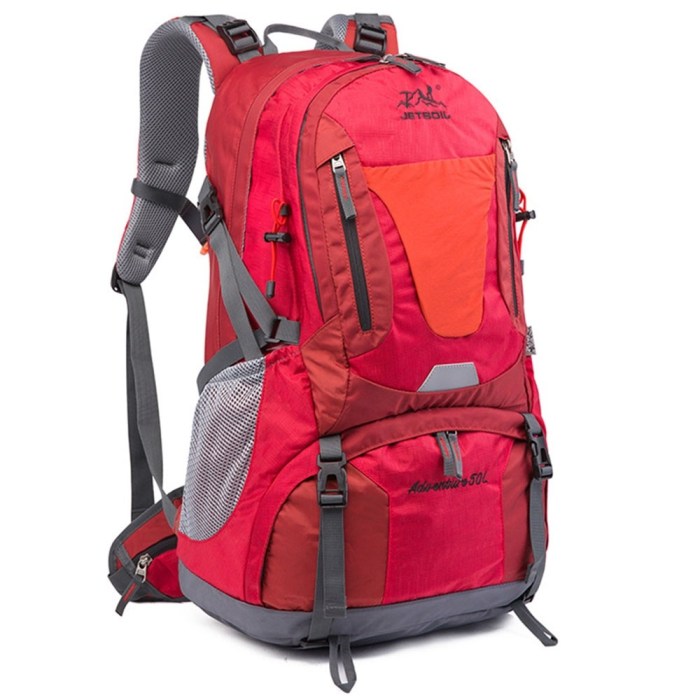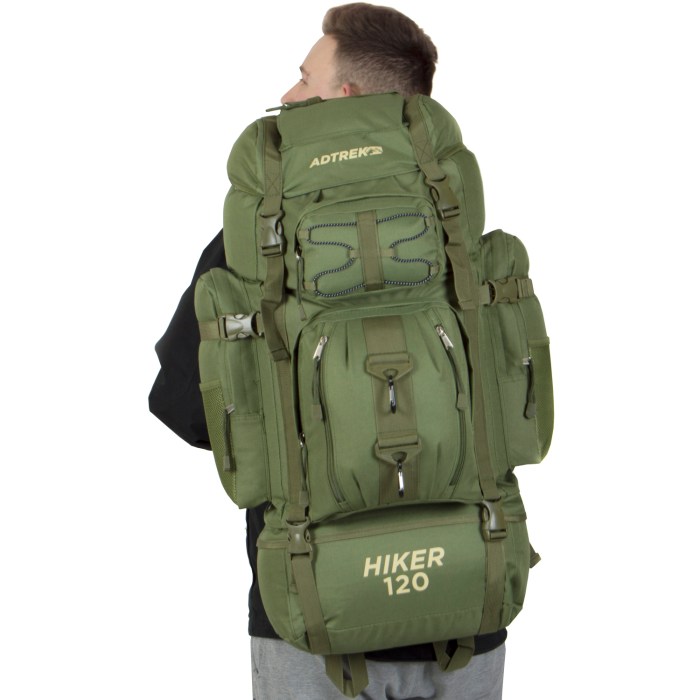Backpacks For Camping: Choosing the right backpack is crucial for a successful camping trip. This isn’t just about carrying your gear; it’s about comfort, efficiency, and ultimately, enjoying your experience in the great outdoors. We’ll dissect every aspect, from understanding the different types of backpacks and their ideal uses to mastering packing techniques that minimize strain and maximize space.
Get ready to transform your camping game.
From internal frame backpacks ideal for long treks to lightweight frameless options perfect for car camping, we’ll cover the spectrum. We’ll delve into capacity, sizing, essential features, and durable materials. You’ll learn how to select the perfect backpack based on trip length, gear weight, and your personal comfort preferences. This comprehensive guide will equip you with the knowledge to make an informed decision and ensure your next camping adventure is both comfortable and unforgettable.
Materials and Durability

Choosing the right materials for your camping backpack is crucial for its longevity and overall performance. The material directly impacts weight, water resistance, tear strength, and ultimately, how long your backpack will last through countless adventures. Understanding these material properties is key to making an informed purchase.
The durability of a camping backpack isn’t solely determined by the material used; the quality of construction plays an equally important role. Factors such as stitching strength, reinforcement in high-stress areas, and the overall design contribute significantly to a backpack’s ability to withstand the rigors of outdoor use. A well-made backpack, even with a less expensive material, can often outperform a poorly constructed one made from a premium fabric.
Nylon and Polyester: A Material Comparison
Nylon and polyester are the two most common materials used in camping backpacks. Both are synthetic fibers offering excellent strength-to-weight ratios. Nylon, however, generally boasts superior abrasion resistance and tear strength, making it a popular choice for heavy-duty backpacks. Polyester, on the other hand, tends to be more resistant to stretching and UV degradation, leading to better long-term color retention.
The choice between nylon and polyester often comes down to prioritizing specific performance characteristics. For example, a backpack designed for heavy loads and frequent rugged use might favor nylon’s superior tear strength, while a lightweight backpacking pack might prioritize polyester’s resistance to stretching and its slightly lower weight.
Ripstop Fabric: Enhanced Durability
Ripstop nylon or polyester incorporates a grid-like reinforcement of thicker threads. This design significantly improves the fabric’s tear resistance, preventing small tears from spreading. While ripstop fabric might be slightly heavier than its non-ripstop counterpart, this added weight is often justified by the increased durability it provides. Imagine a scenario where your backpack snags on a branch; ripstop fabric is far less likely to suffer a catastrophic tear, ensuring your gear remains protected.
The Influence of Stitching and Water Resistance
High-quality stitching is paramount to a backpack’s longevity. Double or triple stitching in high-stress areas, such as the shoulder straps and base, significantly increases the backpack’s resistance to tearing and wear. The type of thread used also matters; stronger, more durable threads are less prone to breaking under strain. Water resistance is another crucial factor. Many backpacks utilize a Durable Water Repellent (DWR) coating to shed light rain and moisture.
However, the effectiveness of this coating diminishes over time with repeated use and washing. Some backpacks utilize more advanced waterproofing techniques, such as fully waterproof liners or seam sealing, for enhanced protection in challenging weather conditions.
Material Weight and Performance
The weight of a backpack significantly impacts its overall performance. Lighter materials, such as certain types of nylon or polyester, result in a lighter backpack, reducing fatigue during long hikes. However, lighter materials might compromise durability. A heavier-duty backpack, constructed from thicker, more durable materials, might be more resistant to wear and tear but will naturally add to the overall weight carried.
The optimal material choice often involves a trade-off between weight and durability, depending on the intended use and personal preferences. For instance, a lightweight backpacking trip might prioritize a lighter pack, while an expedition requiring heavy gear might favor a more robust, heavier backpack.
Packing Techniques for Camping Backpacks
Efficiently packing your camping backpack is crucial for a comfortable and enjoyable trip. Improper packing can lead to discomfort, back pain, and even injury. Mastering effective packing techniques ensures optimal weight distribution, maximizing space utilization and minimizing strain on your body. This section will provide a strategic approach to packing, transforming your backpacking experience from a struggle into a seamless adventure.
The key to successful backpack packing lies in understanding weight distribution and item placement. Heavier items should always be positioned close to your back, near your center of gravity. This minimizes leverage and prevents the pack from swaying excessively, reducing fatigue during your trek. Conversely, lighter items should be packed towards the top and sides, maintaining balance and accessibility.
Optimizing Weight Distribution
Packing your backpack strategically involves placing heavier items closest to your back, ideally within the main compartment. Think of this as your pack’s core. This could include your tent, sleeping bag, and cooking pot. These items form the base of your load, providing stability and minimizing the pack’s tendency to shift during movement. Imagine a pyramid structure; the heavier items are the base, providing a solid foundation for the rest of your gear.
Maximizing Space Utilization
Space is at a premium in a camping backpack, so efficient packing is essential. Smaller items can be nested within larger ones to maximize space and reduce wasted volume. For example, socks and underwear can be stuffed into empty spaces within your sleeping bag compression sack, minimizing air pockets and consolidating items. Utilizing compression sacks for clothing and other compressible items is also crucial for reducing bulk.
Step-by-Step Packing Guide
Follow these steps for optimal packing:
- Base Layer (Bottom): Place the heaviest items – tent, sleeping bag, cooking pot – at the very bottom of your pack, closest to your back.
- Mid-Layer (Middle): Pack moderately heavy items such as food, fuel, and clothing. Distribute weight evenly around the heavier base layer items.
- Top Layer (Top): Place lighter items like a first-aid kit, rain gear, and headlamps at the top. Items you’ll need frequent access to should be in easily accessible pockets.
- External Attachment: Use external straps and pockets for items like trekking poles, sleeping pad, and a jacket.
Visual Representation of an Optimally Packed Backpack, Backpacks For Camping
Imagine your backpack as a three-dimensional structure. The bottom third, closest to your back, is filled with the heaviest items: your tent, snugly nestled against your back, followed by your sleeping bag rolled tightly, and finally, your cooking pot sitting securely on top. The middle third houses your food supplies in waterproof bags, strategically placed to balance the weight, along with clothing items packed in compression sacks.
The top third contains lighter items, such as a first-aid kit, your headlamp, and a lightweight rain jacket, easily accessible in external pockets. Trekking poles are secured to the exterior straps, and a sleeping pad is strapped to the bottom or side, optimizing weight distribution and space.
Backpack Maintenance and Care: Backpacks For Camping

Proper backpack maintenance is crucial for extending its lifespan and ensuring reliable performance on your adventures. Neglecting your pack can lead to premature wear and tear, potentially leaving you stranded with a broken backpack miles from civilization. By following a few simple steps, you can keep your pack in top condition for years to come. This involves regular cleaning, prompt repair of minor damage, and appropriate storage when not in use.
Regular cleaning prevents dirt and grime from accumulating and degrading the fabric. Addressing minor issues promptly prevents them from escalating into major problems, saving you time, money, and potential headaches during your trips. Correct storage protects your backpack from moisture, mildew, and other environmental factors that can compromise its integrity.
Cleaning and Maintaining a Camping Backpack
Cleaning your backpack should be a routine part of post-trip maintenance. Begin by emptying the pack completely, removing all loose debris. Inspect the interior and exterior for any visible damage. Then, use a soft brush or sponge to gently remove loose dirt and grime. For tougher stains, you can use a mild detergent mixed with lukewarm water.
Avoid harsh chemicals or abrasive cleaners, as these can damage the fabric or waterproofing. After cleaning, rinse thoroughly with clean water and allow the backpack to air dry completely, away from direct sunlight or heat. Stuffing the pack loosely with clean towels can help it retain its shape while drying. For water-resistant backpacks, applying a water-resistant spray according to the manufacturer’s instructions can help maintain its protective properties.
Addressing Rips, Tears, and Broken Zippers
Minor rips and tears can often be repaired at home with a heavy-duty needle and thread, or specialized repair tape designed for outdoor gear. For larger tears, professional repair might be necessary. Always use thread that matches the backpack’s material for a seamless repair. Broken zippers can be a more significant issue. If only a slider is broken, replacing it is often a simple fix.
However, if the zipper teeth are damaged, a professional repair or replacement might be required. Consider taking it to a reputable outdoor gear repair shop for more extensive damage. For temporary fixes, you can use zipper tape to keep the zipper closed until a permanent solution can be implemented. A small amount of silicone lubricant can help to ease a stiff zipper.
Proper Storage of a Camping Backpack
Proper storage is essential for preventing damage and preserving the backpack’s condition. Before storing, ensure the backpack is completely clean and dry. Store the backpack in a cool, dry place away from direct sunlight and extreme temperatures. Avoid storing it in damp areas, attics, or basements, which can lead to mildew and mold growth. To maintain its shape, you can loosely stuff the pack with clean, dry cloths or bubble wrap.
Using a breathable storage bag can also help protect it from dust and other debris. Hanging the backpack by its shoulder straps in a well-ventilated area is also a good option. Avoid storing heavy items inside the backpack for prolonged periods.
Selecting the perfect backpack for your camping adventures is a game-changer. By understanding the nuances of backpack types, capacity, features, and packing techniques, you’ll not only carry your gear efficiently but also enhance your overall camping experience. Remember, a well-chosen backpack isn’t just about transporting your equipment; it’s about investing in comfort, durability, and ultimately, creating lasting memories in the wilderness.
So, gear up, get informed, and embark on your next outdoor adventure with confidence!

